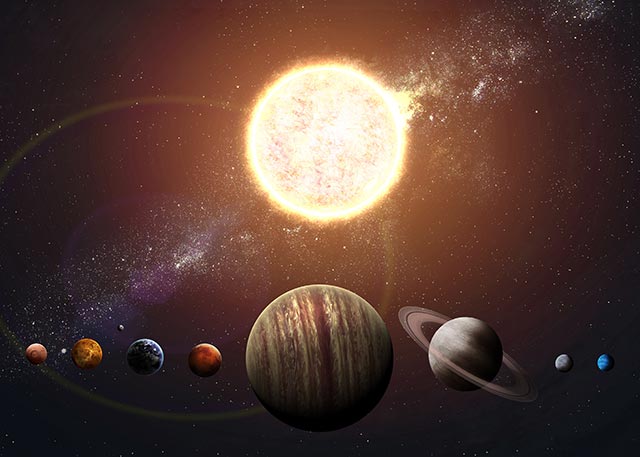Webb Telescope spots “disappearing” gas planet in Earth’s cosmic backyard that may host life-supporting moons
08/12/2025 / By Cassie B.

- Astronomers using NASA’s James Webb Space Telescope have detected a Saturn-sized gas giant orbiting Alpha Centauri A, the closest Sun-like star to Earth at just 4.5 light-years away.
- The planet’s potential icy moons could harbor conditions for life, mirroring Jupiter’s Europa or Saturn’s Enceladus, although the gas giant itself is inhospitable.
- The discovery shocked scientists when the planet “vanished” in follow-up observations, possibly due to its elliptical orbit or the star’s glare, leaving its existence in question.
- Alpha Centauri’s chaotic binary star system challenges current planet formation theories, making this gas giant a puzzling exception if confirmed.
- Future telescopes like the Nancy Grace Roman Space Telescope could study the planet and its moons in unprecedented detail, offering clues about habitability beyond our solar system.
Could there be life beyond our planet? Astronomers using NASA’s James Webb Space Telescope (JWST) have uncovered strong evidence of a Saturn-sized gas giant orbiting Alpha Centauri A, a Sun-like star just 4.5 light-years from Earth. This marks the closest potential exoplanet ever detected around a star similar to our Sun, raising tantalizing questions about the possibility of habitable moons lurking in its orbit. While the gas giant itself is shrouded in thick, life-hostile clouds, its icy moons could offer the right conditions for life to emerge, much like Jupiter’s Europa or Saturn’s Enceladus in our own solar system.
The discovery, first reported in The Astrophysical Journal Letters, has sent shockwaves through the scientific community, not only for its proximity to Earth but also for the planet’s mysterious “disappearance” in follow-up observations. Could this be a cosmic illusion, or is the planet simply hiding in the blinding glare of its parent star? The answer may reshape our search for life beyond our solar system.
A planet in our cosmic backyard
Alpha Centauri, the closest star system to Earth, has long fascinated astronomers as a prime candidate for finding exoplanets. Composed of three stars — Alpha Centauri A, Alpha Centauri B, and the red dwarf Proxima Centauri — the system has already yielded three confirmed planets around Proxima. But finding worlds around the Sun-like Alpha Centauri A and B has been notoriously difficult due to their brightness and gravitational interactions.
Now, the JWST’s Mid-Infrared Instrument (MIRI) has delivered the strongest evidence yet of a gas giant orbiting Alpha Centauri A. Initial observations in August 2024 revealed a faint object roughly 10,000 times dimmer than its host star, positioned at about twice the Earth-Sun distance.
“This is an incredibly exciting find,” said Dr. Carly Howett, a space instrumentation expert at the University of Oxford. “Four light-years is a long way for us, but in the context of our galaxy, it’s very close—it’s practically in our cosmic backyard.”
Yet, when astronomers looked again in February and April 2025, the planet had vanished. Researchers suspect it may have been obscured by its star’s overwhelming brightness or moved too close to be detected. Computer simulations suggest the planet follows an elliptical orbit, swinging close enough to its star at times to evade detection.
The hunt for habitable moons
While the gas giant itself is inhospitable as it is likely enveloped in a thick, turbulent atmosphere, its potential moons could be a different story. In our own solar system, gas giants like Jupiter and Saturn host icy moons with subsurface oceans, considered prime candidates for extraterrestrial life. Europa, for instance, harbors a hidden ocean beneath its frozen crust, and NASA’s upcoming Europa Clipper mission aims to probe its habitability.
If confirmed, the moons surrounding this planet could provide similar conditions. The key difference? This system’s proximity. At just 4.5 light-years away, Alpha Centauri provides an unparalleled opportunity for detailed study. Future observations with the JWST and NASA’s upcoming Nancy Grace Roman Space Telescope (set to launch in 2027) could analyze the planet’s composition and even search for signs of water or organic molecules on any orbiting moons.
A challenge to planetary science
The discovery also poses a puzzle for astronomers. Alpha Centauri A and B orbit each other closely, creating a chaotic gravitational environment that, in theory, should disrupt planet formation. “Its very existence in a system of two closely separated stars would challenge our understanding of how planets form, survive, and evolve in chaotic environments,” study co-first author Aniket Sanghi noted. If confirmed, this planet would defy current models, forcing scientists to rethink how worlds emerge in binary star systems.
Charles Beichman of NASA’s Jet Propulsion Laboratory emphasized the significance: “With this system being so close to us, any exoplanets found would offer our best opportunity to collect data on planetary systems other than our own.” Yet, he acknowledged the difficulty of the task, as the stars’ brightness and rapid motion complicate observations.
What this means for Earth
Beyond the scientific intrigue, the discovery reignites humanity’s age-old question: Are we alone in the universe? While the gas giant itself may not host life, its moons, if they exist, could be the next frontier in the search for extraterrestrial habitats. The JWST’s ability to peer into the infrared spectrum, combined with the Roman Telescope’s future visible-light imaging, may soon provide answers.
For now, the “disappearing” planet remains a tantalizing mystery. Is it a fleeting cosmic illusion, or a world waiting to be rediscovered? Either way, its detection marks a milestone in exoplanet science, and it’s one that brings us closer than ever to finding a habitable neighbor in the stars.
Sources for this article include:
Submit a correction >>
Tagged Under:
breakthrough, cosmic, discoveries, exoplanets, gas giant, moons, planets, real investigations, research, Space, space exploration, Stars, Universe
This article may contain statements that reflect the opinion of the author





















